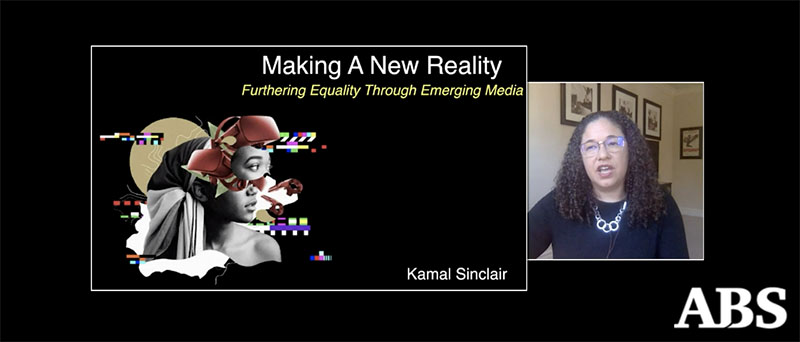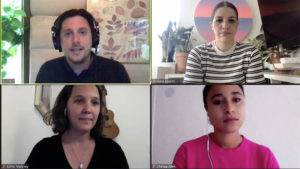



The technology of media, and how it is shaping culture, is central to the concerns of a number of presenters at the 2020 online conference of the Association for Baha’i Studies. Here are a few perspectives:
Keynote presentation: Kamal Sinclair, “Making a New Reality,” Aug. 1
For Kamal Sinclair, today’s wave of technology is disrupting the way humanity sees reality and meaning, much as the multiplication of printing presses did centuries ago. This is happening alongside many social disruptions: the pandemic, climate change, large-scale contention over old social assumptions, and more.
While it’s being designed, “our perceptual limitations” might hinder it, she noted. She called for “a collective and equitable imagination of our future” so that “diversity and inclusion will actually lead us to the best of what is possible.”
To give these new media the best chance to benefit from humanity’s collective knowledge, she said, the conversation shaping it must include a constellation of people representing all races and cultures; men and women; artists, philosophers, humanities scholars and more, side by side with business and technical thought leaders.


She referred to teachings of ‘Abdu’l-Baha about how the rational soul discovers “the mysteries of existence” and is connected to the creation of “great works of art and science.”
Through their rational faculties, people collectively devise a “communication architecture” to share such discoveries. It can be as simple as body language, storytelling and crude paintings or as complex as the written word and formal arts.
Major disruptions to humanity’s communication architecture came from the growth of printing five centuries ago, as well as the emergence of images of Earth from outer space in the 20th century. Both expanded the human race’s sense of reality, and artists and philosophers helped make sense of these new perspectives.
What are today’s disruptors? Sinclair identified a dizzying array of emerging information and entertainment media:
As powerfully as they can reshape people’s view of the world, she asked: What voices are shaping their design? From interviews, conferences and research, two forces she sees dominating such conversations are:
Lack of voices to counter dominant narratives, she said, has led to “disasters.” In 1915 Hollywood’s first-ever feature film, The Birth of a Nation, promoted white supremacy, setting the tone for the movie industry at the start. The Industrial Revolution’s single-minded focus on financial growth and exploitation of nature has led over the years to dangerous climate change. And lack of empathy for diverse voices is preventing America from gaining a shared vision of the future — in turn fueling “ideological wars.”
Still, history shows that people can intervene to bring human priorities into influential design processes, often providing a “boon” that enhances collective prosperity. She mentioned the mid-20th century movement in New York City to slow the destruction of neighborhoods and parks, and the establishment of public broadcasting to serve the needs of the commons in ways commercial television will not.
She invited examining the website makinganewreality.org for more examples of efforts to increase inclusion, share knowledge across disciplines, validate voices in arts and humanities, and encourage parity in entrepreneurship and investment.
As the world evolves to become more and more dependent on tech to manage and process the information we take in, Sinclair said, people must be brought together to ask, “What does this mean for well-being, for unity, for diversity, for justice and equity?”
Collaborative initiative: Media and Youth — Insights from ABS Reading Groups, Aug. 5
Our society is saturated with media, and young people are swept up in it. This session shared some insights gained over a month or more from two reading groups, populated largely by media and arts professionals and focusing on the themes “Youth, Narrative Media, and Cultural Production” and “Achieving Coherence in Media.”


A 2019 study examined by the first group shows “teens and tweens” use media an average of nine hours a day, but only spend 3 percent of that time creating. Esther Maloney said that using this and other studies, the group is discussing how this imbalance can be addressed by the Baha’i imperative to make young people protagonists in their own development. The group is asking, “What might it look like to overcome a sense of passivity related to our media consumption and engagement patterns?”
Among related questions: How to address injustices that can grow from imbalances between consuming and creating? How does this affect conditions for social change? Can young people be empowered not just from learning how to code, but from gaining a sense of digital and social literacy along with that?
The second group, grounding its reading in Baha’i teachings on the arts, is working toward a coherent vision of the role of media in the light of human nature, the greatness of this time in history, and the Baha’i revelation itself, said Chelsea Allen and Nava Kavelin. Baha’i teachings indicate temporary troubles are necessary to achieve a more humane and just society, Kavelin noted, adding: “How do we infuse what we create with that understanding?”
One study looked at three films on current topics — the food industry, U.S. education and a local health crisis — and examined how people say those films changed their behavior, with an eye toward how they were funded and their tone of empowerment or pessimism. Allen said offering hope may well be a main outcome of a spiritually and financially coherent model for producing media. She quoted Shoghi Effendi, head of the Baha’i Faith from 1921 to 1957, as envisioning that “a new era will dawn in art and literature,” in which spiritual content will be as fully developed as the form.


![]()
![]()
Whether you are exploring the Bahá'í Faith or looking to become an active member, there are various ways you can connect with our community.
Please ensure that all the Required Fields* are completed before submitting.